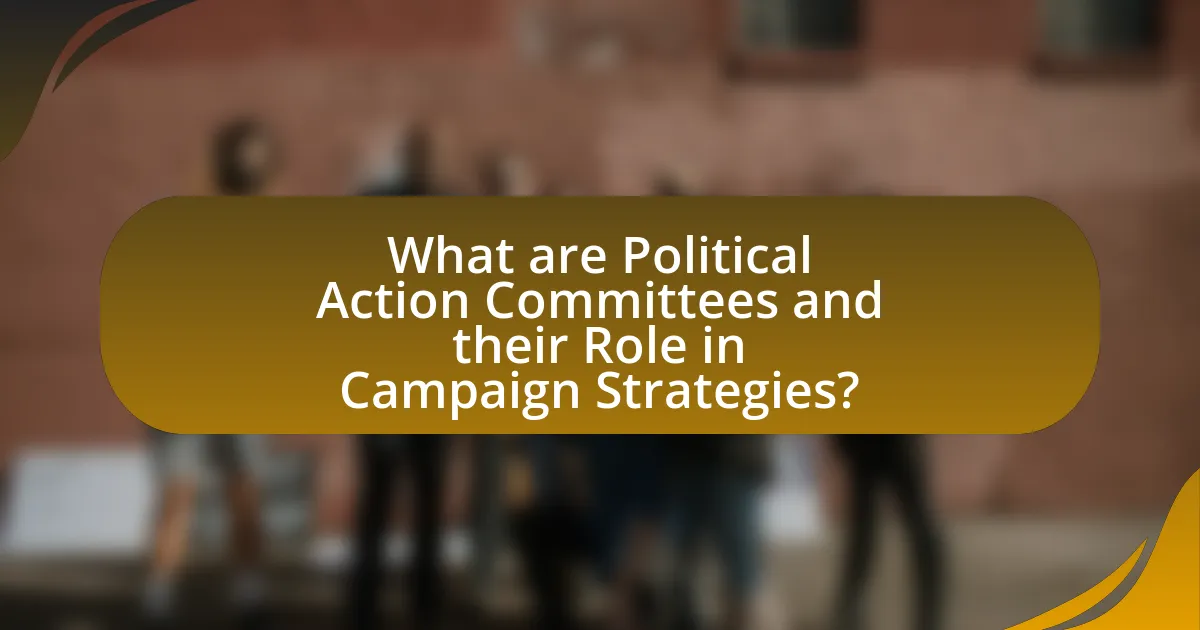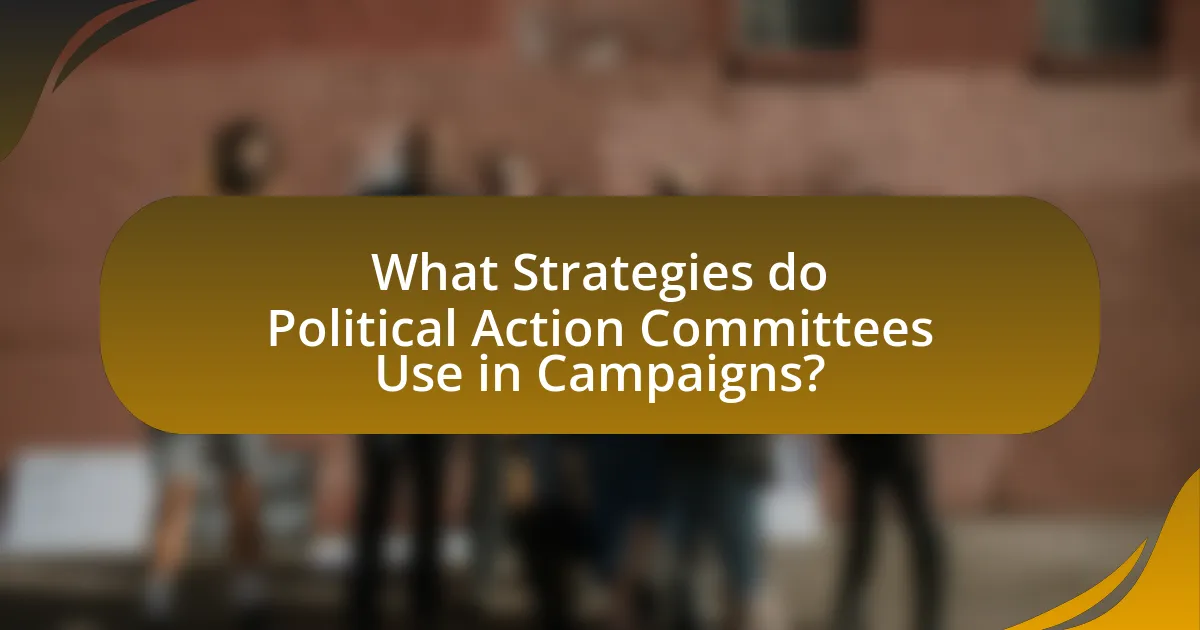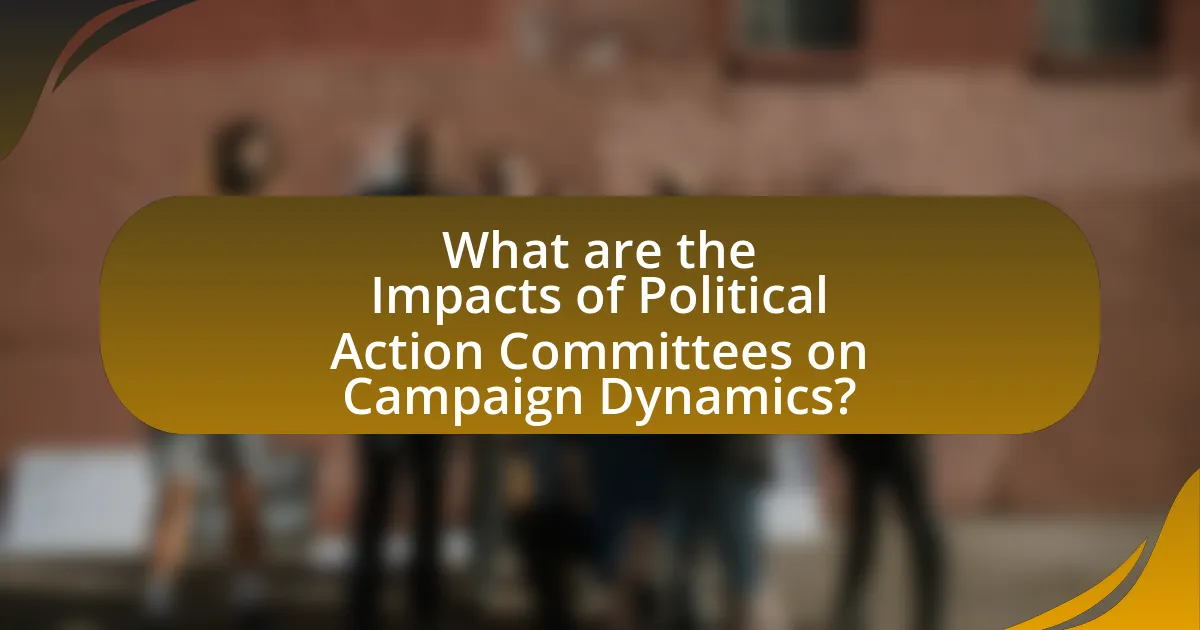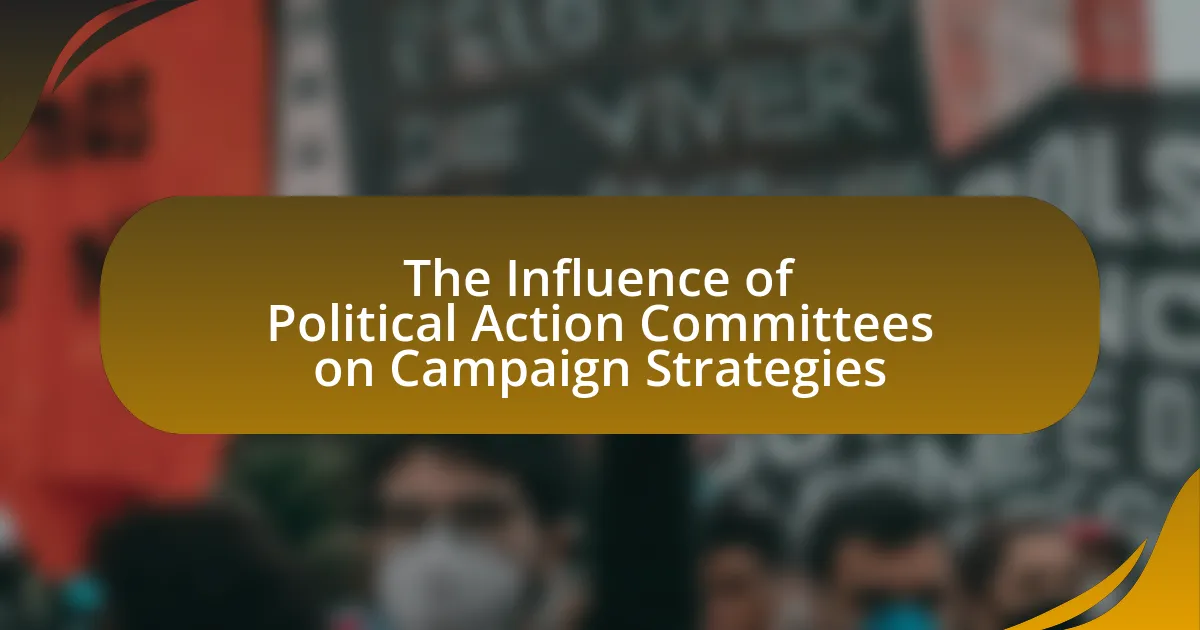Political Action Committees (PACs) are organizations that collect and distribute funds to support political candidates and influence legislation, playing a vital role in campaign strategies. The article examines how PACs impact electoral outcomes through financial contributions, the different types of PACs, and their operational mechanisms. It also explores the historical changes that have shaped PACs, their influence on voter engagement, and the strategies they employ in campaigns. Additionally, the article addresses the ethical considerations surrounding PACs, the regulatory landscape governing their operations, and the potential consequences of unchecked PAC influence on democracy. Finally, it outlines best practices for candidates working with PACs to enhance their campaign effectiveness.

What are Political Action Committees and their Role in Campaign Strategies?
Political Action Committees (PACs) are organizations that collect and distribute funds to support political candidates and influence legislation. PACs play a crucial role in campaign strategies by providing financial resources that candidates need for advertising, outreach, and mobilization efforts. In the 2020 election cycle, for example, PACs contributed over $1.5 billion to various candidates, highlighting their significant impact on campaign financing. By aligning with specific political interests, PACs help shape the electoral landscape, ensuring that candidates who support their agendas receive the necessary funding to compete effectively.
How do Political Action Committees influence electoral outcomes?
Political Action Committees (PACs) influence electoral outcomes primarily through financial contributions to candidates and political parties. These contributions can significantly enhance a candidate’s visibility and competitiveness in elections, as evidenced by the 2010 U.S. Supreme Court decision in Citizens United v. FEC, which allowed for increased spending by PACs. Research indicates that candidates receiving substantial PAC funding often experience higher electoral success rates; for instance, a study by the Center for Responsive Politics found that candidates who received PAC contributions were more likely to win their races compared to those who did not. Additionally, PACs can shape public opinion and voter behavior through targeted advertising and mobilization efforts, further impacting electoral results.
What types of Political Action Committees exist?
There are several types of Political Action Committees (PACs), including traditional PACs, Super PACs, and hybrid PACs. Traditional PACs are organizations that collect contributions from members and donate them to candidates or political parties, adhering to contribution limits set by the Federal Election Commission. Super PACs, on the other hand, can raise and spend unlimited amounts of money to advocate for or against political candidates but cannot directly contribute to candidates or coordinate with their campaigns. Hybrid PACs combine features of both traditional and Super PACs, allowing them to contribute directly to candidates while also engaging in independent expenditures. These distinctions are crucial for understanding the regulatory landscape and the strategic influence PACs have on campaign strategies.
How do different types of Political Action Committees operate?
Different types of Political Action Committees (PACs) operate by raising and spending money to influence elections and legislation. There are two primary categories of PACs: connected PACs, which are affiliated with corporations, labor unions, or membership organizations, and independent PACs, which operate independently of any specific organization. Connected PACs can only solicit contributions from individuals associated with their organization, while independent PACs can raise funds from the general public without such restrictions.
For example, in the 2020 election cycle, connected PACs contributed over $1 billion to candidates, while independent PACs, including Super PACs, raised more than $2.7 billion, demonstrating their significant role in shaping campaign strategies. Super PACs, a subset of independent PACs, can accept unlimited contributions and spend unlimited amounts on political advertising, further amplifying their influence. This operational structure allows PACs to strategically target candidates and issues, thereby impacting electoral outcomes and legislative agendas.
Why are Political Action Committees important in modern politics?
Political Action Committees (PACs) are important in modern politics because they enable organized fundraising and spending to influence elections and legislation. PACs collect contributions from members and donate those funds to candidates who align with their interests, thereby amplifying the voices of specific groups, such as corporations, labor unions, or ideological organizations. In the 2020 election cycle, for instance, PACs contributed over $1.5 billion to candidates, highlighting their significant role in shaping electoral outcomes and policy decisions. This financial support can determine the viability of candidates and influence legislative agendas, making PACs a crucial element in the political landscape.
What historical changes have shaped the role of Political Action Committees?
Political Action Committees (PACs) have been shaped by several historical changes, notably the Federal Election Campaign Act of 1971, which established the legal framework for PACs and set limits on contributions. This act allowed for the formal organization of PACs, enabling them to raise and spend money to influence elections. Subsequent amendments, such as the Bipartisan Campaign Reform Act of 2002, further regulated PAC activities by banning soft money contributions to national parties and imposing stricter rules on advertising. Additionally, the Supreme Court’s decision in Citizens United v. FEC (2010) significantly altered the landscape by allowing corporations and unions to spend unlimited amounts on independent political expenditures, leading to the rise of Super PACs. These changes collectively expanded the influence of PACs in campaign strategies, allowing for greater financial resources and strategic coordination in political campaigns.
How do Political Action Committees affect voter engagement?
Political Action Committees (PACs) significantly enhance voter engagement by funding campaigns and mobilizing grassroots efforts. PACs provide financial resources that enable candidates to reach a broader audience through advertisements and outreach initiatives, which can increase voter awareness and participation. For instance, a study by the Center for Responsive Politics found that in the 2020 election cycle, PACs contributed over $1.5 billion to candidates, which correlates with higher voter turnout in competitive districts. Additionally, PACs often organize events and volunteer efforts that directly involve voters, fostering a sense of community and encouraging civic participation.

What Strategies do Political Action Committees Use in Campaigns?
Political Action Committees (PACs) employ various strategies in campaigns, primarily focusing on fundraising, voter mobilization, and targeted advertising. Fundraising is crucial, as PACs collect contributions from individuals and organizations to support candidates aligned with their interests; for instance, in the 2020 election cycle, PACs contributed over $1.5 billion to candidates. Voter mobilization efforts include organizing grassroots campaigns and utilizing data analytics to identify and engage potential voters, which enhances turnout rates. Additionally, targeted advertising allows PACs to influence public opinion by disseminating messages through television, social media, and direct mail, often focusing on specific demographics or issues relevant to their agenda. These strategies collectively amplify the impact of PACs on electoral outcomes and policy decisions.
How do Political Action Committees allocate their resources?
Political Action Committees (PACs) allocate their resources primarily through contributions to candidates, political parties, and issue advocacy campaigns. PACs assess the political landscape, focusing on candidates who align with their interests, and distribute funds to maximize their influence on election outcomes. For instance, in the 2020 election cycle, PACs contributed over $1.5 billion to various candidates and parties, demonstrating their significant financial impact on campaign strategies. This allocation strategy is often guided by polling data, electoral viability, and the potential return on investment in terms of policy influence.
What factors influence funding decisions by Political Action Committees?
Funding decisions by Political Action Committees (PACs) are primarily influenced by the political alignment of candidates, the perceived viability of those candidates, and the specific interests of the PACs. PACs typically prioritize candidates who align with their ideological goals, as this increases the likelihood of favorable policy outcomes. Additionally, PACs assess the competitiveness of races; they are more likely to fund candidates who have a realistic chance of winning, as evidenced by polling data and fundraising capabilities. Furthermore, the interests represented by the PAC, such as business sectors or social causes, play a crucial role in determining where funds are allocated, ensuring that contributions support candidates who will advocate for those specific interests.
How do Political Action Committees prioritize candidates or issues?
Political Action Committees (PACs) prioritize candidates or issues based on alignment with their specific political goals and the potential for electoral success. PACs assess candidates’ positions on key issues, their voting records, and their ability to mobilize support within their constituencies. For instance, a PAC focused on environmental issues may prioritize candidates who advocate for climate change legislation and have a history of supporting such policies. Additionally, PACs often analyze polling data and electoral trends to identify candidates who are likely to win, thereby maximizing the impact of their contributions. This strategic approach is evidenced by the significant financial backing that PACs provide to candidates who align with their interests, as seen in the 2020 election cycle where PACs contributed over $1 billion to various campaigns, influencing the outcomes in numerous races.
What messaging strategies do Political Action Committees employ?
Political Action Committees (PACs) employ targeted messaging strategies to influence voter perceptions and mobilize support for candidates or issues. These strategies include emotional appeals, data-driven messaging, and issue framing. Emotional appeals often leverage fear or hope to resonate with voters, while data-driven messaging uses statistics and facts to establish credibility and urgency. Additionally, PACs frame issues in a way that aligns with their objectives, often simplifying complex topics to enhance understanding and engagement. For instance, during the 2020 election cycle, PACs utilized social media platforms to disseminate tailored messages that addressed specific voter concerns, demonstrating the effectiveness of these strategies in shaping public opinion and driving electoral outcomes.
How do Political Action Committees tailor their messages to different audiences?
Political Action Committees (PACs) tailor their messages to different audiences by analyzing demographic data, voter preferences, and key issues relevant to specific groups. For instance, PACs often segment their target audiences based on factors such as age, income, education level, and political affiliation, allowing them to craft messages that resonate with each segment’s values and concerns. Research indicates that PACs utilize targeted advertising and social media strategies to reach these audiences effectively, employing language and imagery that align with the interests of each group. This approach is supported by data showing that personalized messaging can increase engagement and mobilization among voters, ultimately influencing campaign outcomes.
What role does social media play in the strategies of Political Action Committees?
Social media serves as a critical tool for Political Action Committees (PACs) by enabling them to engage with voters, disseminate information, and mobilize support efficiently. PACs utilize platforms like Facebook, Twitter, and Instagram to reach targeted demographics, allowing for tailored messaging that resonates with specific voter groups. For instance, a study by the Pew Research Center found that 69% of adults in the U.S. use social media, highlighting its potential reach for political messaging. Additionally, social media facilitates real-time interaction, enabling PACs to respond quickly to political developments and public sentiment, which can significantly influence campaign strategies and voter turnout.

What are the Impacts of Political Action Committees on Campaign Dynamics?
Political Action Committees (PACs) significantly influence campaign dynamics by providing substantial financial support to candidates, which can alter the competitive landscape of elections. PACs enable candidates to amplify their messaging and outreach efforts, often leading to increased visibility and voter engagement. For instance, according to the Center for Responsive Politics, in the 2020 election cycle, PACs contributed over $1.5 billion to various campaigns, demonstrating their financial clout. This influx of resources can shift the focus of campaigns, as candidates may prioritize issues that align with their PAC supporters’ interests, thereby shaping policy discussions and voter perceptions.
How do Political Action Committees shape candidate behavior?
Political Action Committees (PACs) shape candidate behavior by providing financial support and resources that influence campaign strategies and priorities. Candidates often align their positions and messaging with the interests of the PACs that fund them, as these organizations can significantly impact their electoral success. For instance, according to the Center for Responsive Politics, in the 2020 election cycle, PACs contributed over $1.5 billion to candidates, demonstrating their substantial role in shaping political agendas. This financial backing can lead candidates to prioritize issues that align with the PACs’ goals, thereby affecting legislative behavior once elected.
What pressures do candidates face from Political Action Committees?
Candidates face significant pressures from Political Action Committees (PACs) primarily in the form of financial contributions and strategic endorsements. PACs often provide substantial funding that can influence a candidate’s campaign priorities and messaging, compelling candidates to align their positions with the interests of the PACs that support them. For instance, according to the Center for Responsive Politics, in the 2020 election cycle, PACs contributed over $1.5 billion to candidates, which underscores their financial clout. This financial dependency can lead candidates to prioritize the agendas of their PAC supporters over broader constituent interests, thereby shaping their campaign strategies and policy proposals.
How do Political Action Committees influence policy positions of candidates?
Political Action Committees (PACs) influence the policy positions of candidates primarily through financial contributions and strategic support. By providing substantial funding for campaigns, PACs can sway candidates to align their policy positions with the interests of the contributors. For instance, a study by the Center for Responsive Politics found that candidates who receive significant donations from PACs often adopt policy stances that reflect the priorities of those PACs, particularly in areas like healthcare, energy, and taxation. This financial backing can also facilitate access to candidates, allowing PACs to lobby for specific policy agendas directly, thereby reinforcing the alignment between candidate positions and PAC interests.
What are the ethical considerations surrounding Political Action Committees?
The ethical considerations surrounding Political Action Committees (PACs) include issues of transparency, accountability, and the potential for undue influence on political processes. PACs often operate with significant financial resources, which can lead to concerns about the disproportionate impact of wealthy donors on elections and policy decisions. For instance, the Supreme Court’s 2010 decision in Citizens United v. FEC allowed for unlimited independent expenditures by corporations and unions, raising ethical questions about the integrity of democratic processes and the potential for corruption. Additionally, the lack of stringent disclosure requirements can obscure the sources of funding, making it difficult for voters to understand who is influencing their representatives. These factors contribute to ongoing debates about the role of money in politics and the ethical implications of PAC activities.
How do regulations affect the operations of Political Action Committees?
Regulations significantly shape the operations of Political Action Committees (PACs) by imposing limits on contributions and expenditures. These regulations, established by the Federal Election Commission, dictate how much money individuals and organizations can donate to PACs and how PACs can spend their funds during election campaigns. For instance, federal law restricts individual contributions to PACs to $5,000 per year, which directly influences the fundraising strategies of these committees. Additionally, regulations require PACs to disclose their financial activities, ensuring transparency and accountability, which can affect their public perception and operational strategies.
What are the potential consequences of unchecked Political Action Committee influence?
Unchecked Political Action Committee (PAC) influence can lead to significant consequences, including the erosion of democratic processes and increased political polarization. When PACs operate without regulation, they can disproportionately amplify the voices of wealthy donors, resulting in policies that favor special interests over the general public. For instance, a study by the Brennan Center for Justice found that in the 2018 midterm elections, candidates who received substantial PAC funding were more likely to prioritize the interests of those donors, often at the expense of broader voter concerns. This dynamic can undermine public trust in government and exacerbate inequalities in political representation, as the interests of average citizens may be sidelined in favor of those with greater financial resources.
What best practices can candidates adopt when working with Political Action Committees?
Candidates should establish clear communication and alignment of goals with Political Action Committees (PACs) to maximize their effectiveness. This involves articulating campaign objectives and ensuring that the PAC’s funding strategies align with the candidate’s values and messaging. Additionally, candidates should maintain transparency regarding financial contributions and expenditures, as this builds trust with both the PAC and the electorate.
Research indicates that candidates who effectively collaborate with PACs can significantly enhance their campaign reach and funding, as evidenced by the 2020 election cycle where candidates who engaged with PACs saw an average increase of 30% in campaign contributions compared to those who did not. Furthermore, candidates should actively participate in PAC events and initiatives, fostering relationships that can lead to strategic endorsements and grassroots support.
